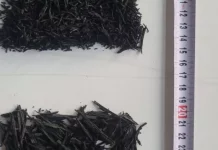DM Monitoring
NANJING: Archeologists have identified four species of organisms from frondose fossils, which once lived at the bottom of the ocean 550 million years ago, from Shibantan Biota in the Three Gorges area of central China’s Hubei Province, in the upper stream of the Yangtze River.
The fossils in the shape of “leaves” are actually early animals. The four paleontological species, which are now extinct, have a body length of about 10 cm. These ancient “leaves” have round suckers at the bottom that adsorbed to the sea bed, while the “stems” and “leaves” stood upright in the sea.
The research on frondose fossils was conducted by PhD candidate Wang Xiaopeng, associate professor Pang Ke and professor Chen Zhe from the Nanjing Institute of Geology and Palaeontology affiliated to the Chinese Academy of Sciences, as well as professor Xiao Shuhai from Virginia Tech in the United States.
“These seabed ‘leaves’ were part of a large group with a wide distribution. Studying the fossils may provide important clues to explore the evolution of early life,” said Pang.
The paper on the research has been published in the Journal of Paleontology.






